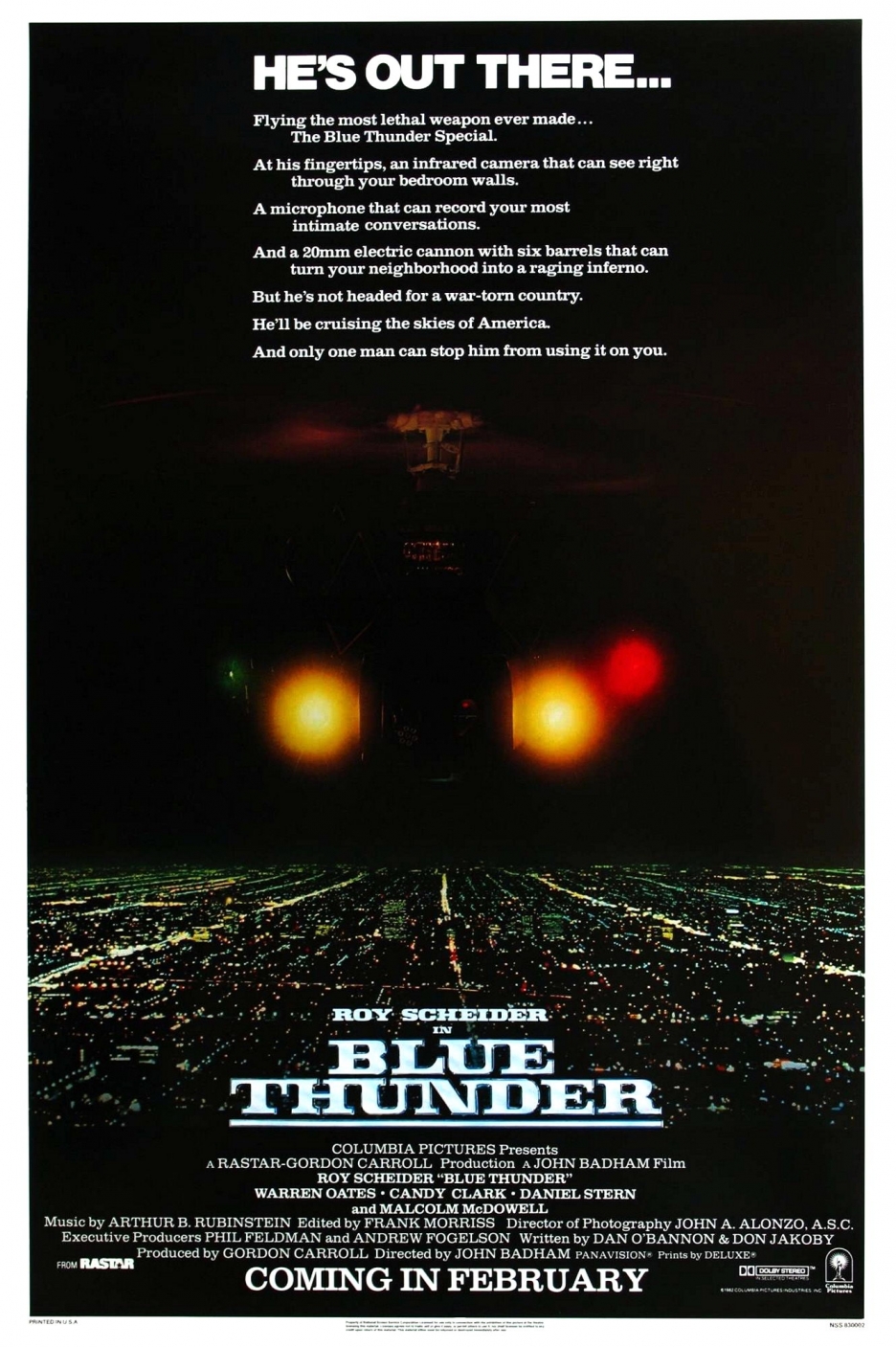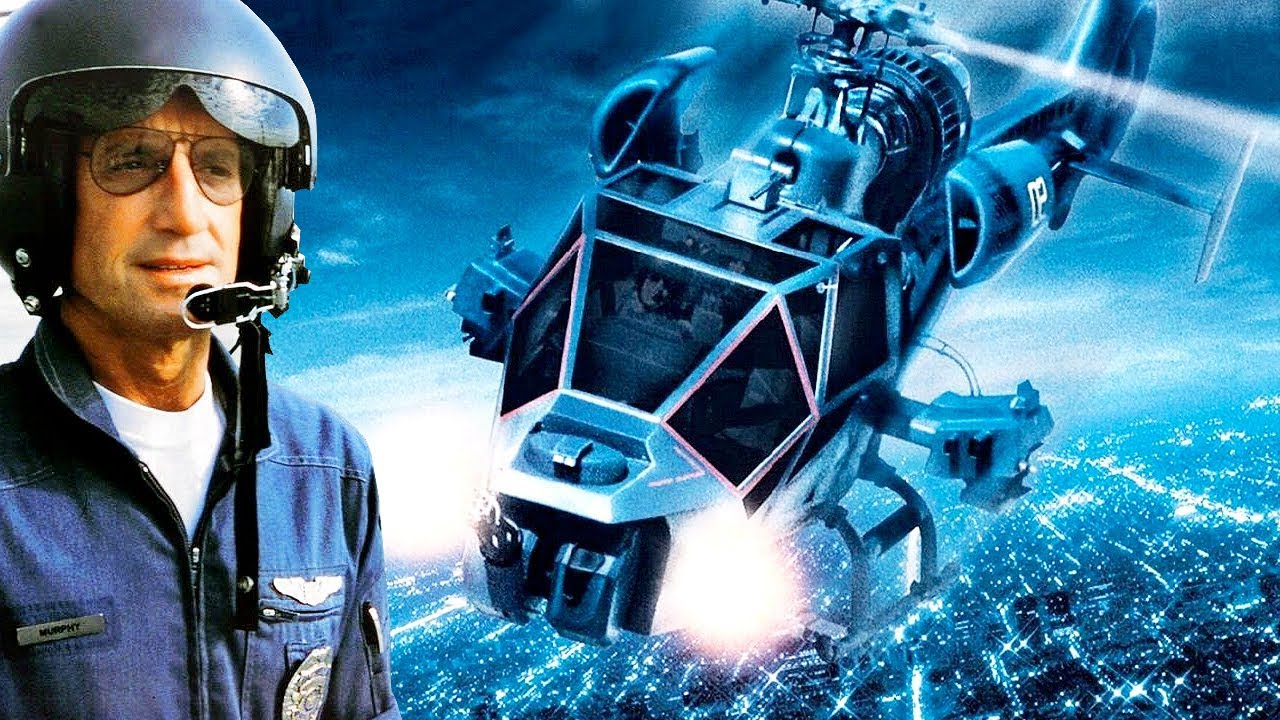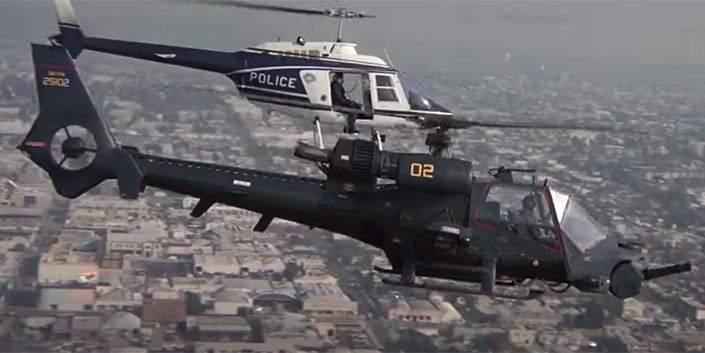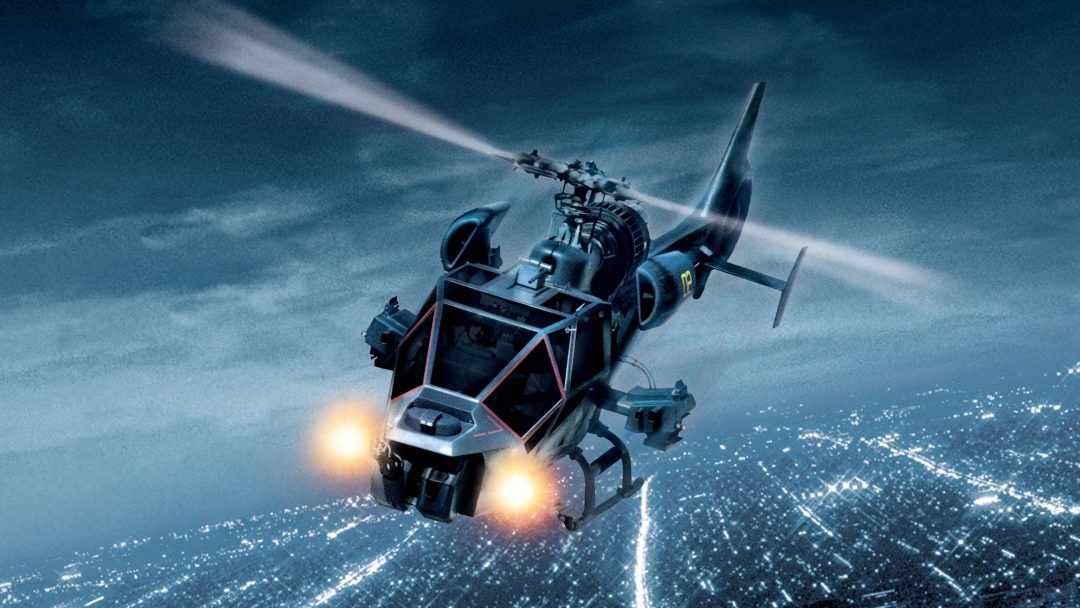We really aren’t joking when we say how much we love an Outposter contribution. We set this place up, in the dark days that followed scandal-riddled, sex-crime tinged, ban hammer-powered exodus from a certain ginger-themed website, with the sole intent of being a community. A community for movie fans to hang out and shoot the breeze largely free from overzealous moderation and the thought police. When one of our beloved Outposters sends us an article, it makes us think we must be doing something right. Like this one, another contribution from Mr Horta – his review of Blue Thunder.
Do you have something about movies, TV, streaming, or the industry you want to share with your fellow Outposters? Send it in to [email protected] and become internet famous!

Retro Review: Blue Thunder
In 1983, a buzz came over the 8-plex: You had to see Return of the Jedi but it’s kind of a letdown. Another buzz, meanwhile, had fallen quiet.
(Blue Thunder’s super-rotor switched to Whisper Mode.)
“THE HARDWARE, WEAPONRY AND SURVEILLANCE SYSTEMS DEPICTED IN THIS FILM ARE REAL AND IN USE IN THE UNITED STATES TODAY.”
Blue Thunder tells us this. For some films, that would be the closing onscreen text as a bitter punch line. This one puts it up front as a statement of purpose, right after the glimmering Columbia Pictures logo and the staticky murmur of air traffic control. We then lurch into a thriller with more on its mind than a lot of its action-oriented peers. It’s not perfect by any means, but in its own way, it kicks ass.
Overview
Blue Thunder landed at an interesting time. While the early-mid ’70s gave us a steady stream of evil-powers-that-be movies, often resulting in dead or devastated protagonists and cynical despair, the Lucas-Spielberg boom steered us toward upbeat endings. Blue Thunder straddles that line: corruption is pervasive but One Good Crusader can triumph, if not without deadly consequences.
Among the more notable rescues of Blue Thunder is that it kept Roy Scheider from having to appear in Jaws 3D and director John Badham didn’t have to take on an ill-advised sequel to his 1977 blockbuster Saturday Night Fever. Stallone, weirdly enough, stepped in for Stayin’ Alive. Badham did find time to helm 1983 classic Wargames. When’s the last time a journeyman had a year that great?
Thus Blue Thunder is probably the only movie in which a noted actor and director jump into an attack helicopter to escape a failing dance studio and a killer shark. Jaws, as we know, is unafraid of helicopters.

The titular helicopter is part huge robot insect, part Sharper Image jewelry display case, and part battering ram. It’s suitably menacing and represents the Special Vehicle (SV) concept well. Pioneered by Bond and Batman, the SV elevated a lot of creative properties. TV had its share of SVs. Knight Rider, Street Hawk, Airwolf, and so on. So did a number of ’80s movies like Black Moon Rising, Buckaroo Banzai, the Mad Max movies, Ghostbusters, Back to the Future, Firefox, Deal of the Century, and more. The latter two are part of a sub-genre of “Spectacular Aerial Climax” movies, to which we could potentially add D.A.R.Y.L. and Dragonslayer to the list with Blue Thunder.
Blue Thunder, co-written by Alien writer Dan O’Bannon, nearly doubled its $22 million budget in earnings before Return Of The Jedi swept in. Not enough for a sequel but acceptable for a TV show with James Farentino taking over as lead. That’s how you do it: Keep the high-tech centerpiece, and lose the movie’s dramatic baggage.
The Plot
The story beats are genre-familiar. Scheider is Frank Murphy, an L.A.P.D. helicopter pilot with Vietnam-related PTSD. He’s teamed with Daniel Stern’s brand-new rookie Lymangood.
Lymangood is our vulnerable, wide-eyed audience surrogate, as happily surprised as many of us that Blue Thunder gets to its obligatory ’80s T&A early when he and Murphy, in their police helicopter, spy on a hot woman doing naked yoga in her living room. Understand that in the pre-chapter-skip DVD era of VHS, T&A sooner was better. All Lymangood needs is to be newly engaged or expecting his first child.

Murphy has a quirky girlfriend, Kate (Candy Clark), and a boss on his ass. Soon he’s wowed by an amazing new helicopter. He learns its test pilot is an antagonist from his Vietnam past (Malcolm McDowell’s obnoxiously murderous Cochrane). Murphy and Lymangood take Blue Thunder for a spin at night and with its surveillance equipment eavesdrop on a secret meeting. Suddenly they’ve uncovered a conspiracy to militarize the police and now bad people are after them. Violence escalates. Finally, we get to the main event: the air duel between Murphy in a stolen Blue Thunder and everyone else over L.A.
Overall
Blue Thunder has trouble getting out of its own way story-wise at times and a can’t-help-it dated synth score. It could use a tighter edit—probably its single biggest flaw. It’s possible most scenes could be cut by 30 seconds for a 10-minute-shorter movie; it’s almost a surprise there isn’t a mayoral campaign subplot. But we should credit its attention to character, even if results are mixed. (How much, by contrast, do we learn about Keanu Reeves in Speed?)
The movie’s look stands out, with great shots of L.A.’s orange-streaked dusk by Scarface cinematographer John Alonzo. Murphy’s sports car pulls up at home with lens-flare arrival; he gets out and walks to his front door in a tracking shot against the gorgeous smog-purple backdrop of the city- beautiful. The handheld widescreen urgency similarly has a tense elegance.
Couple this with charmingly vintage details like shoebox-sized video files and Stephen J. Cannell psycho-to-go Anthony James as a killer. Him as one of the Three Men and a Baby would’ve been hilarious. Not to mention Kate’s race to the TV station to get information about corruption out in time for the five o’clock news.

Blue Thunder loosely anticipates Rodney King. The chopper is designed for urban unrest, presumably by murdering the shit out of rioters. It also feels a bit prescient of 9/11. The latter is realized in the main event, an exceptionally well-done air combat sequence over L.A. The battle has a solid three-act structure with swooping, soaring shots that must’ve been tricky as shit to get; F-16-fired missiles blow up a meat warehouse and explode through a skyscraper, while Blue Thunder tears vehicles apart. A good, well-earned climax.
And who’s on the ground under all that falling debris? We are, 40 years later. Thinking if they could do all that then, what can they do now? Helicopters haven’t gone anywhere except up, criss-crossing our cities at this exact moment – and certainly, there are positive aspects of this in a world where crime exists. Blue Thunder says it’s complicated, suggesting that as long as real people are part of the equation, every now and then one might make a decision in favor of humanity. Not a bad thing to smuggle into a flawed if well-done thriller.

Check back every day for movie news and reviews at the Last Movie Outpost










